Psychology and Road Design - To Err Is Human
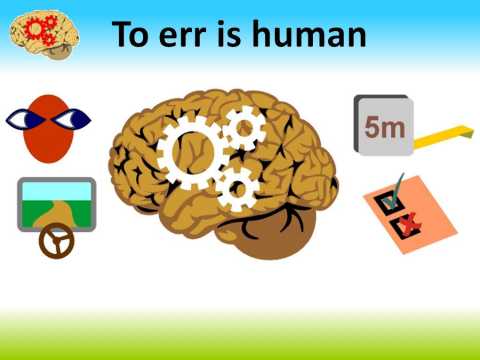 |
So, why do road users make mistakes? Let's start by considering what goes on in a typical road user's head
Unfortunately, until someone invents a small, portable MRI scanner, it's not possible to see directly what goes on in someone's head as they travel. Instead we have to deduce behaviour indirectly through a mix of observations, simulations, measurements, and surveys and questionnaires
However, with so many factors to consider and with such great variety among individuals, psychologists have created many different and often contradictory models to explain road user behaviour |
|
The most common models are variants of the following six step process:
(i) First you control your own position, steering and speed. (ii) Next, you identify an object and (iii) then you compare its position, direction and speed relative to your own
(iv) Next, you assign a danger level and (v) then decide what action to take based on that danger level. (vi) Finally, you implement the action |
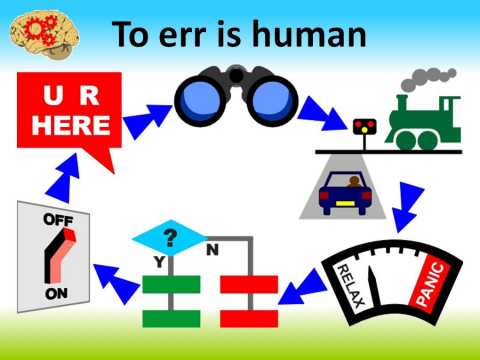 |
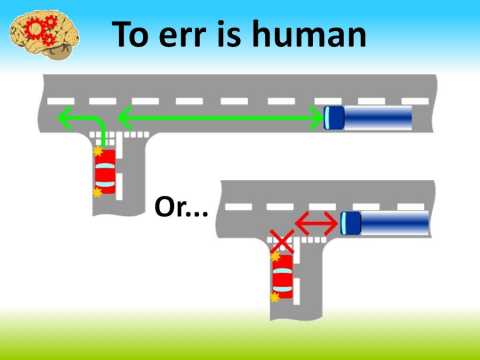 |
For example, you're at a junction waiting to join a busy carriageway. You look to your right (assuming you're in the UK) and see a lorry approaching. Currently it's far away and travelling slowly. So the danger level is low. Therefore you decide it's safe to pull out on to the carriageway
Alternatively the lorry is too close, the danger level is too high, so you wait for the lorry to pass
This process can apply to both motorists and cyclists, or even pedestrians - for example waiting to cross a road |
|
A mistake can happen if one or more of these steps is incorrect: For example you misjudge how close the lorry is or you decide to risk pulling out in front of the lorry
Or a mistake can occur if there isn't enough time to complete the process: For example, by the time the lorry driver's brain reaches and implements the 'apply the brakes' action in response to you pulling out, a crash may have already started to occur |
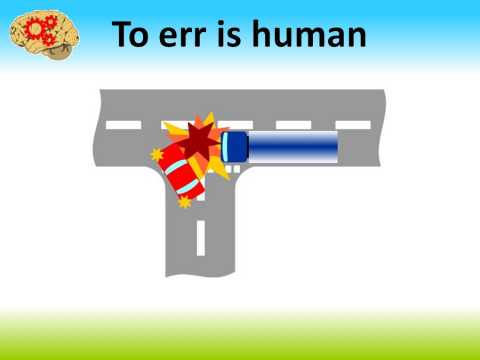 |
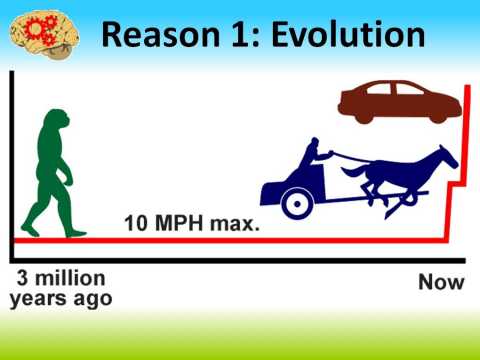 |
So why do we make these mistakes?
A major reason is evolution. Our ancestors started walking upright and running on two feet about 3 million years ago - let's assume a maximum speed of about 10 MPH. They started riding horses and invented the wheel about 4000 years ago, and it's only in the last 100 years that we've been travelling at modern everyday speeds
So for 99% of our evolution our top travelling speed was 10 MPH and our mental processes and our senses, such as vision, haven't had the chance yet to catch up with our modern travel speeds |
|
But it's not all doom and gloom
We've adapted our travel environment by creating flat, smooth, and linear roads that go around, over or under obstacles. We use oversized, colourful and simplified pictograms to warn us of potential hazards and to tell us how to behave. And we follow rules like driving on the left to reduce the likelihood of head-on collisions
Yet, this has in turn has created a second major reason that we make mistakes: |
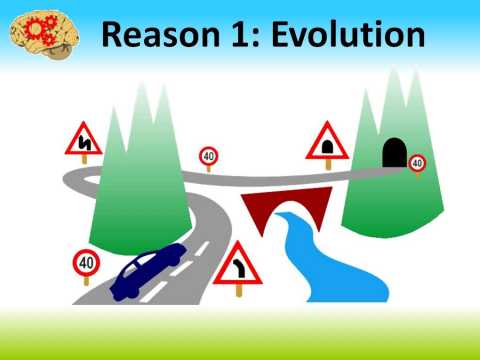 |
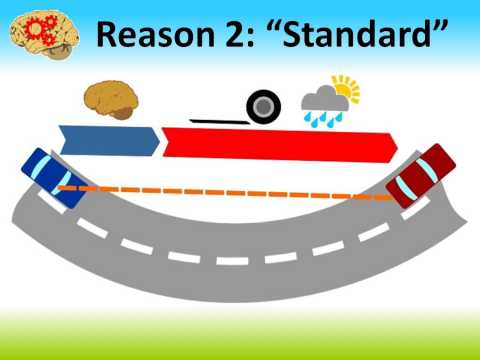 |
Our adapted environment is based on the abilities of a 'standard' road user, driving a 'standard' vehicle on a 'standard' road in 'standard' weather conditions
This diagram shows the distance a 'standard' motorist needs to stop in an emergency, including the thinking distance in blue followed by the braking distance in red
But there's a wide variety of abilities among road users - for example some react faster than others
So do we aim for the lowest common denominator and increase the blue distance to accommodate the slowest reaction times, even if this could entice people with quicker reaction times to travel faster? Or do we reduce this distance to target motorists with quicker reaction times, and hope that people with slower reaction times would self-regulate and drive more slowly anyway? |
|
Let's look at each stage of the common model and note where road design can potentially reduce scope for making mistakes at each step
The first step is to control your own position, steering and speed |
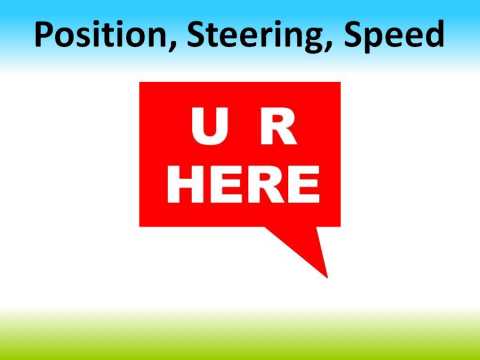 |
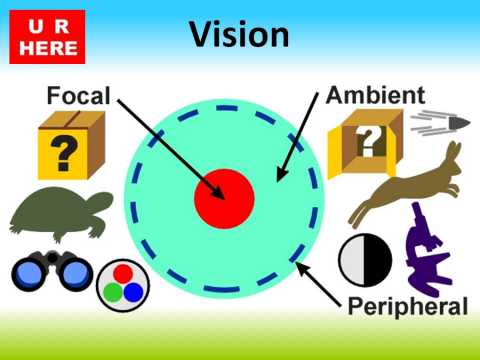 |
This relies predominantly on our vision. Vision comprises of three overlapping zones: Focal, ambient and peripheral
Focal vision is at the centre of where you're looking, and answers the question 'what is it?'. It's better for looking at distant objects, it's good at noticing colours, but requires a lot of mental effort and can take time to identify things
Ambient vision is the space around focal vision and answers the question 'where am I?'. It relies on nearer objects, it's good at noticing contrast and rapid motion, and it's quicker and requires less effort than focal vision. Ambient vision also includes peripheral vision which is around the outer edge |
|
Steering relies on both focal vision to see what's coming and to plan ahead, and on ambient vision to keep within the lane markings |
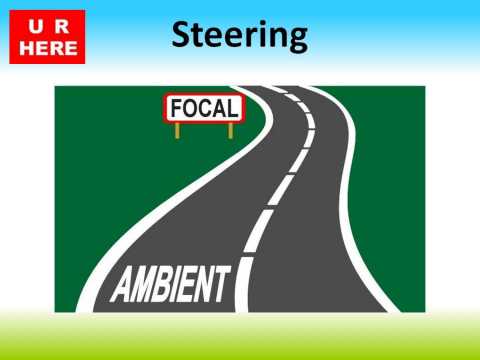 |
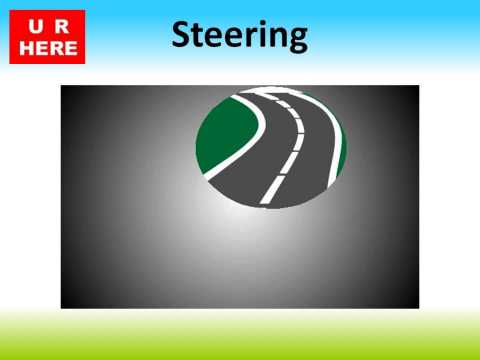 |
We can still steer without ambient vision - for example driving in the winter with only a small area cleared of an iced-covered windscreen - although it's not ideal |
|
But without focal vision our ability to steer deteriorates, and steering can become jerky and we can overcompensate which is a common cause of single vehicle road run-off crashes. Night time and poor weather conditions like fog are examples when our focal vision is impaired |
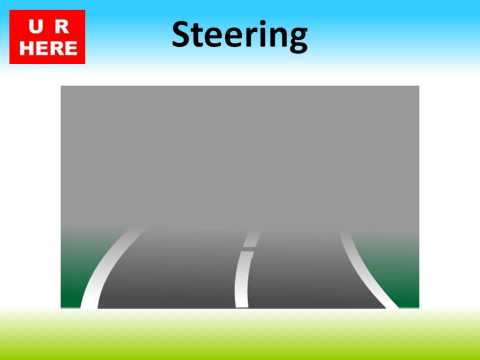 |
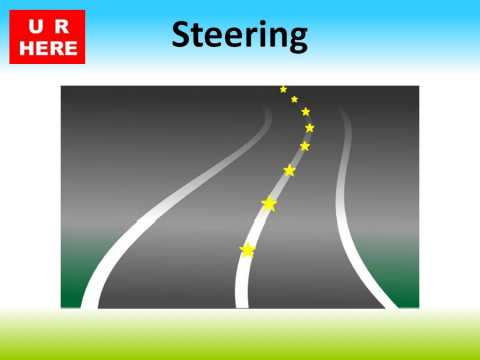 |
To compensate, our roads include edge markings, lanes markings, and cat's eyes to help motorists see further. But this can have negative effects such as making people feel too safe and driving too fast to notice in time, for example, a pedestrian in dark, non-reflective clothing
Also, street lighting can help motorists see hazards such as junctions and pedestrians more clearly at night, make pedestrians feel safer, and point out the direction of the road ahead (particularly on motorways and dual carriageways)
In poorly lit conditions, motorists tend to drive closer to the edge of the road - dangerous for pedestrians on unlit roads at night - so lighting levels need consideration |
|
Another steering issue is that motorists tend to steer where they're looking and look where they're steering. So on this right-hand bend the driver should be looking along the yellow arrow
But if we position a road sign on the left verge here, the driver may instinctively look at it, stop steering round the bend, and leave the road. So in this situation it's usually best to locate the sign before the bend, or consider placing it on the right-hand verge
A similar issue is when an asymmetric road appearance (for example trees down only one side of a road) misleads drivers to think they're heading for the side of the road and compensate their steering unnecessarily. This can lead to increased single vehicle road run-off crashes. So maybe our road designs should avoid asymmetry |
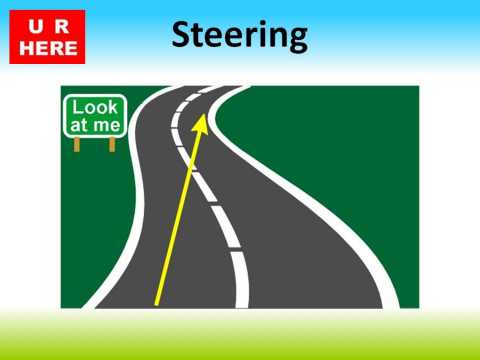 |
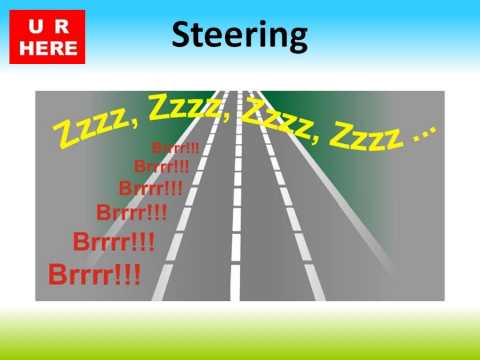 |
Steering can also be affected by boredom and fatigue causing a deterioration in our peripheral vision and lane-keeping ability
Boredom, or 'Highway hypnosis', can be caused by monotonous or repetitive road environments, when the motorist enters a trance-like state and drives on auto-pilot
To counter this problem we can use rumble-strips to alert drivers when they veer out of lane. Some countries even use rumble strips between each lane, not just next to the hard shoulder
Highway hypnosis is not just restricted to motorways and dual carriageways. It can also occur on rural single carriageways, particularly if they're wide or pass through a repetitive or unchanging environment. Rumble strips could be a solution on these roads too |
|
Maintaining our travel speed also relies on our vision
Lateral or transverse road markings at decreasing spacing are already widely used at approaches to roundabouts or traffic lights on faster roads like dual carriageways. These markings rely on peripheral vision to make drivers overestimate their speed and underestimate their deceleration, which in turn makes drivers slow down more quickly
Some countries also use marker posts at decreasing spacing to increase the impact of this effect |
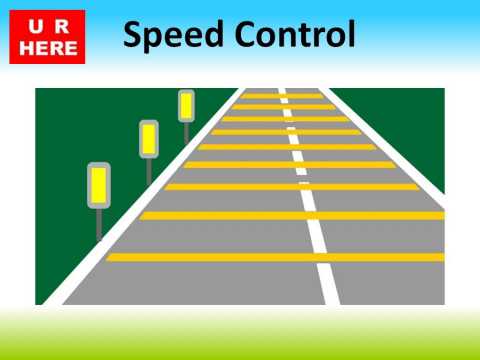 |
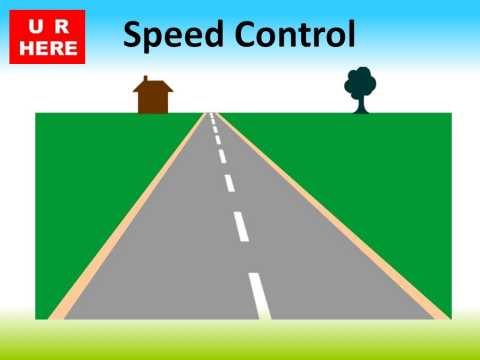 |
Drivers also rely on their peripheral vision to judge overall speed
However, on roads through open countryside with few roadside objects, this can be difficult and drivers will typically underestimate their speed and therefore travel more quickly |
|
But on roads with more roadside objects drivers can subconsciously judge their speed more effectively. So in these conditions drivers will often overestimate their speed and therefore travel more slowly
Examples of roadside objects include things like trees or bushes, walls or buildings, and street furniture like lighting columns and road signs
Therefore if a road in open countryside is suffering from excess speeds, increasing the frequency of roadside objects could help reduce these speeds. For example, on motorways research indicates that vehicles travel more slowly when there are sound barriers to each side |
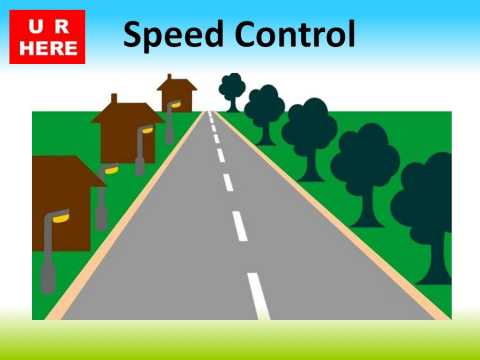 |
 |
When deciding at what speed to drive along a particular road, motorists use mental models triggered by the road's appearance
These mental models are based on past experience, and are an example of 'Cognitive economy'. They enable road users to obtain the maximum amount of information with minimal effort, and they help us avoid brain overload which can be a common reason that people make mistakes
Examples of visual cues are the hard shoulder and central reservation that indicate motorways, or houses, front gardens, reduced lane widths and parked cars which indicate a residential street. These are examples of 'self explaining roads' |
|
'Naked streets' are an increasingly popular type of self explaining road, where the removal of road signs and markings and the mixing of pedestrians and vehicles tell drivers to travel at significantly lower speeds |
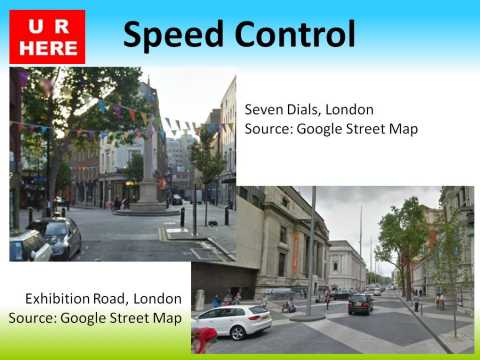 |
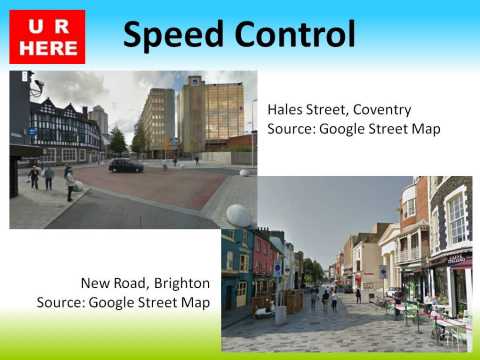 |
While they're not universally popular, statistics show that naked streets reduce casualty rates, although there is debate about why and how
For example, these statistics could be skewed by vulnerable road users (such as the elderly, the mobility impaired, parents with young toddlers, or the visually impaired) staying away from naked streets. If only the more able pedestrians use naked streets, then it's not surprising that casualty statistics would fall
The long term impact and effectiveness of naked streets can also be questioned. If naked streets rely on uncertainty and the 'surprise factor' to make motorists travel more slowly, this will have less impact as motorists become more accustomed to a particular naked street and therefore drive more dominantly and with less attention. In these situations a naked street can quickly revert to a typical segregated street
Nevertheless, from a road design point of view, naked streets offer us more freedom to try out new ideas |
|
Studies have also shown that drivers find it harder to comply with incremental changes in speed limits
For example motorists are more likely to speed unintentionally through a 30 MPH urban area if they passed through lengths of 50 and/or 40 MPH speed limits before entering the urban area - particularly if the road appearance remained unchanged through the various speed limit zones |
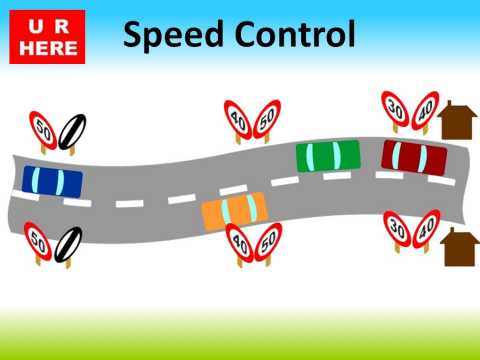 |
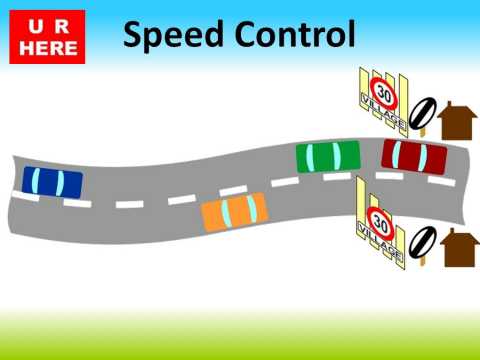 |
While drivers are more likely to comply subconsciously with a 30 MPH speed limit if there is gateway feature where the limit changes directly from 60 to 30 MPH
Such a feature can include public art, street furniture, or a central island. The more unusual it is the more likely the driver is to notice it and therefore comply. This is known as 'cognitive dissonance' |
|
Another consideration is 'Speed adaptation' which is when drivers have difficulty judging slower speeds after travelling fast for a prolonged time - for example driving on local roads after leaving a motorway. This causes drivers to underestimate their actual speed and drive too quickly
On these roads installing vehicle activated speed limit signs, or painting speed limit roundels on the road surface, can help remind motorists to slow down. Flashing signs can be particularly effective because our eyes are naturally drawn towards them |
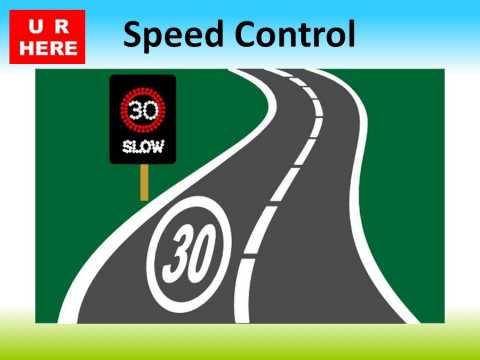 |
 |
Next, the road user needs to look out for and identify objects and potential hazards. This relies predominantly on focal vision to answer the question 'what is it?' |
|
However, our brains would quickly overload if we processed all the visual information as we see it
Therefore we instinctively learn from experience, and develop a number of tools that reduce mental load while still providing enough information to help us identify what's in front of us as we travel |
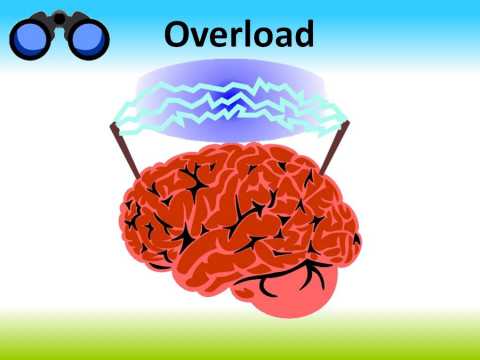 |
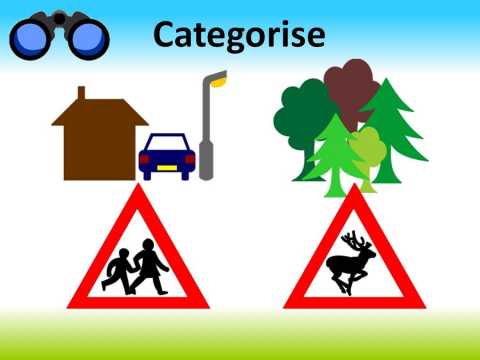 |
First the brain carries out an holistic overview to categorise what is ahead, and then searches for specific features based on the category - for example pedestrians in urban areas, or wildlife in the countryside
However, this can cause problems when the unexpected occurs, or when objects are misinterpreted |
|
A common example of the unexpected is the 'looked but failed to see' phenomenon where drivers collide with motorbikes and bicycles because the drivers were too busy looking out for other types of hazard
Despite motorcyclists being disproportionately more likely to be involved in crashes than any other group of road users, road designs do little to improve motorbike safety. 'Think Bike' road signs are a typical motorbike safety measure, while some street furniture, such as crash barriers, can be more harmful to motorcyclists because it's been designed with cars and lorries in mind
The number of motorbikes on our roads will only increase in the future as congestion gets worse and fuel prices rise. Therefore we need to give greater emphasis to motorcyclist safety in future road designs
For example, motorbike-only lanes, similar to cycle lanes, could be considered at junctions where collisions with motorbikes are an issue |
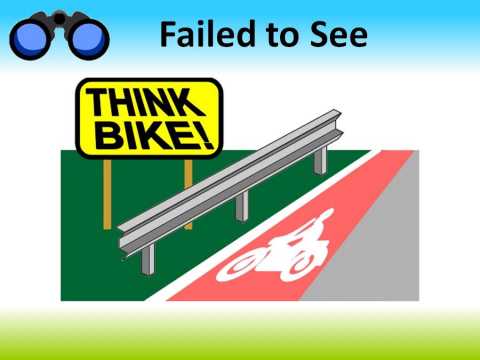 |
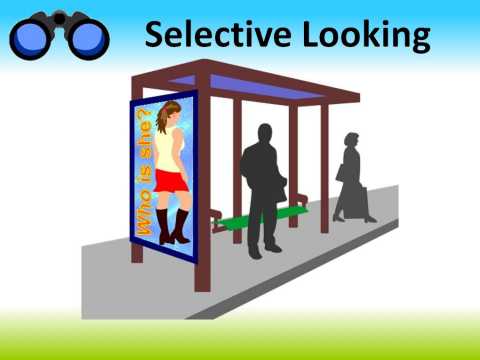 |
A similar problem is when road users focus on one object and fail to see a second, potentially more hazardous object. This is known as 'selective looking' or 'inattentional blindness'
For example a motorist is distracted by a bus-shelter advertisement, and fails to notice a pedestrian about to step into the road
So care is needed to avoid distractions in pedestrian busy areas |
|
Road users can also fail to identify objects if there's conflicting or confusing information
For example don't locate brightly coloured lights in the line of sight of traffic lights |
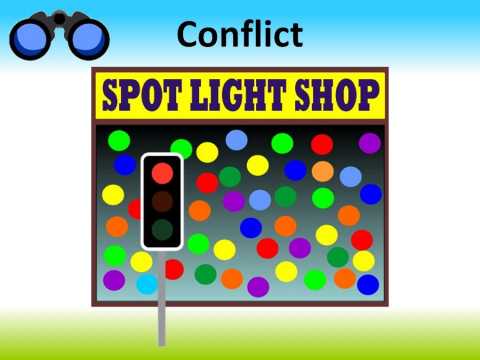 |
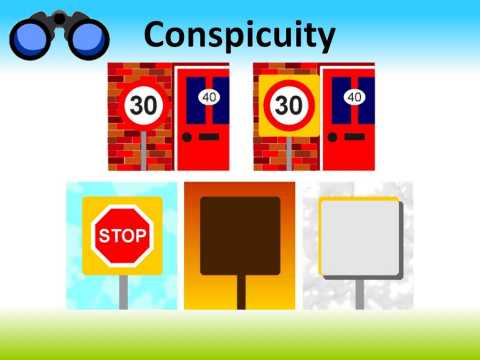 |
Road signs should be located to maximise their visibility. However, where it is unavoidable that road signs might merge into the background - for example a red bordered road sign in front of a red brick building - a yellow back board will make it more conspicuous
However, the overall shape of the road sign can help road users identify signs quickly, and this shape should be maintained if there is a risk of the sign contents being obscured - for example by low sunlight from behind the sign, or by snow covering the sign face. This is most important for stop and give way signs which have unique sign shapes |
|
Further factors to consider when maximising road sign effectiveness include:
(i) Avoiding conflicting information. Here on the left of the slide we have an extreme example of conflicting information, which would confuse drivers
(ii) Road signs also need to be relevant. For example the 'school children' sign is most relevant when children are in transit to and from school. So for the rest of the day, at weekends and during school holidays, motorists become accustomed to ignoring this sign. Using flashing lights with this sign at school transit times only will increase its relevance and improve compliance
(iii) Road signs need to tell drivers what to do. In a survey, when asked about the 'rocks falling' sign, many road users said they sped up when they saw this sign to get past the hazard as quickly as possible. When, of course, they're meant to slow down in case there are rocks in the road |
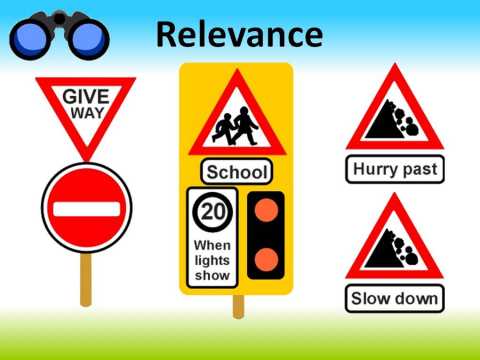 |
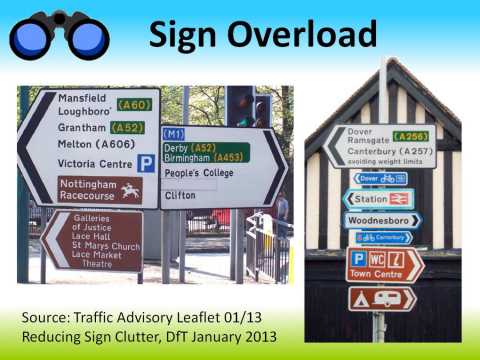 |
A balance also needs to be struck between too many and too few road signs
Too many can overload drivers with information or distract them from the driving task. This is a good example of 'more is less' as the more information your road signs provide, the less that information is going to be noticed and correctly interpreted
At the other extreme, too few road signs can lead to motorists getting lost, getting stressed and driving more erratically |
|
Complex junctions can be particularly confusing to road users unfamiliar with the road layout, for example visitors new to the area
These road users are at greater risk of mistaking traffic lights for a different queue as applying to their queue, and setting off across a junction when in fact they don't have the right of way
Such junctions should be simplified where possible, or replaced with roundabouts, or louvred screens can be fitted to the traffic light heads, particularly the green, to limit the distance from which the traffic lights are visible
Similarly, the positioning of traffic lights needs careful consideration. The system we have in the UK can often prompt motorists at the head of a queue to look up or across the junction to see when the traffic lights turn green. However, this increases the risk that they will fail to notice pedestrians still crossing the road
Moving the stop line further back from the pedestrians crossing could make pedestrians more visibile, or maybe we should consider low-level repeater traffic lights at the eye level of the lead motorist. These are commonplace in Continental Europe - for example France |
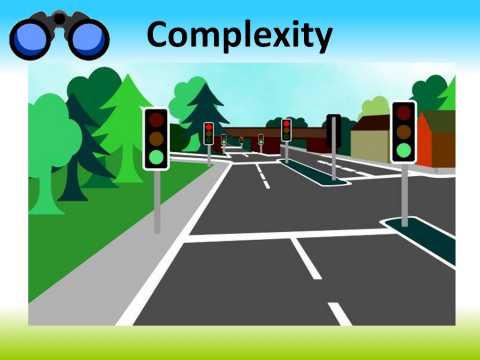 |
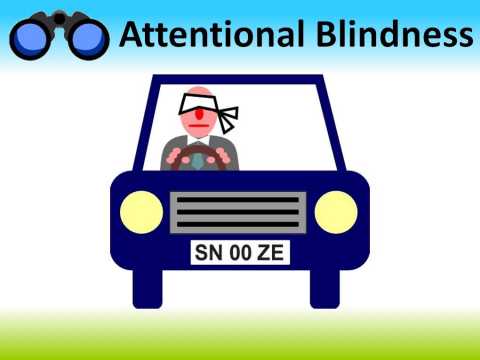 |
Most road users make the same journeys each day, for example commuting or going shopping, or repeat the same long distance routes, for example visiting relatives or friends who live further afield
This prolonged, repeated travel can become automated, with drivers no longer needing to concentrate on lane positioning or speed control
This can lead to 'attentional blindness' as drivers pay less attention because they think the journey is easy. Instead they might look out for 'landmarks' like junctions, bridges, or even pot-holes
But this increases the chances that they may miss or misinterpret unexpected hazards like bicycles, pedestrians or stationary cars |
|
A common example of misinterpreting what we see is when motorists on motorways or dual carriageways assume stationary vehicles in front of them are still in motion and don't brake until too late
This problem occurs because the silhouette or image of the back of a vehicle is the same whether it is moving or stationary, and drivers assume by default that vehicles on motorways or dual carriageways are in motion, as is the case most of the time
This helps explain why emergency vehicles on hard shoulders still suffer from rear impact collisions, despite all their flashing lights |
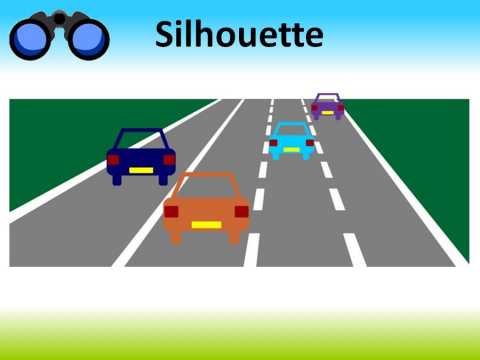 |
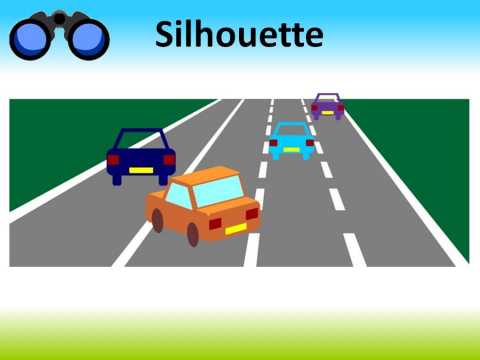 |
A possible solution is to widen the hard shoulder so that vehicles can stop at an angle to the carriageway (for example between 33 and 45 degrees) and therefore provide a silhouette or rear-view of their vehicle which differs significantly from that of vehicles in motion
In this example the stationary vehicle is actually in lane one, not the hard shoulder - just such a situation could occur on a managed motorway, or in road works |
|
So far we've focused on the needs of adult road users. But of course, road users include children, many of whom are still learning and developing their road safety skills
Young children in particular are still learning their left from their right, so they might look in the wrong direction, and they're also still learning what to look out for
Even when they look before crossing a road, they might fail to identify an approaching vehicle as a hazard because they don't yet have sufficient experience
Therefore special considerations are required in these locations. We might consider creating more home zones or pedestrian crossings to reinforce to motorists that vulnerable pedestrians are nearby |
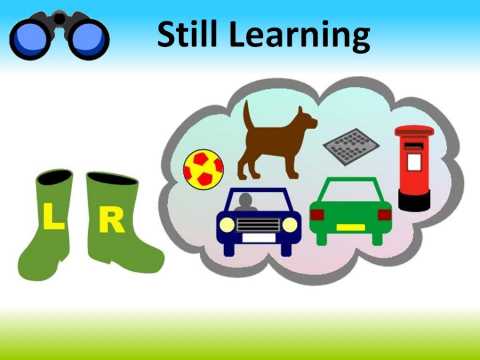 |
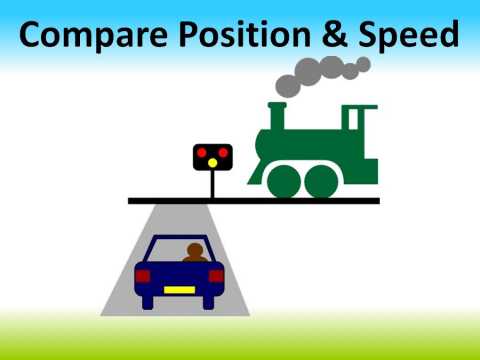 |
Having identified an object, we next need to compare its position, direction and speed to our own to determine if our paths will cross
This applies equally to mobile objects like other vehicles or pedestrians, and to stationary objects like trees or potholes |
|
We rely on our focal vision to look at distant objects. But focal vision is poor at judging long distances and far-away speeds. Therefore road users compare the size of the approaching object with a mental image of a notional 'normal' sized object - usually a medium-sized car
This means road users typically think large vehicles, like vans, buses, lorries, and trains (at level crossings), are closer than they really are, but travelling more slowly, while smaller objects like small cars and motorbikes are further away, but travelling more quickly
This confusion makes it difficult to judge gaps in traffic, affects road users both at side roads and waiting to turn across traffic, and can cause crashes. For example, when the approaching object fails to act as the road user expected, such as taking a long time to approach, there is a higher risk that the road user will make a mistake and pull out at the wrong time
This issue applies to cyclists as well as motorists, and is also a problem for pedestrians waiting for gaps in traffic before crossing the road |
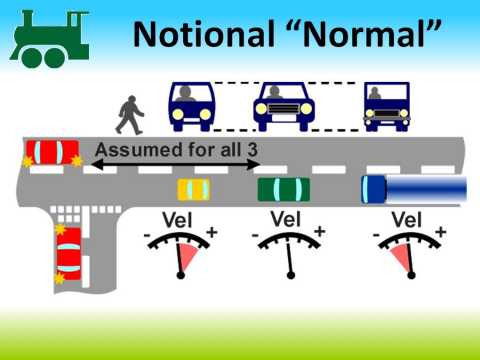 |
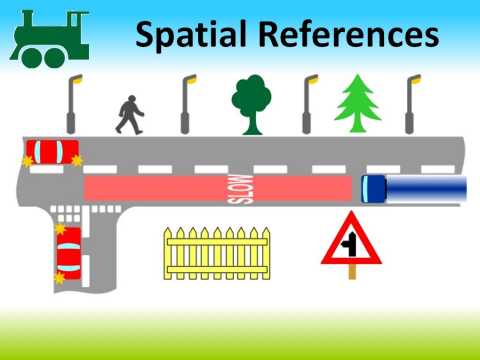 |
To counter this problem we can place road signs or other street furniture to act as unofficial spatial reference markers at the approaches to junctions or where pedestrians cross a road
Road users can then see when approaching objects pass these markers and therefore judge speeds and gaps in traffic more accurately. Reference markers can also include lighting columns, vegetation, fencing, road markings, and even the start of anti-skid surfacing |
Studies have shown that road users find it more difficult to judge vehicle speeds on curved slip roads or slip roads joining dual carriageways on bends because of the complex mix of lateral and longitudinal movement, when compared to straight slip roads or slip roads joining straight sections of carriageway. Therefore our road designs should use straight slip roads as the first option
Cyclists and pedestrians can often misinterpret actions of other road users. They see a vehicle slowing down and assume this is to allow them to join or cross the road, when in fact the vehicle was slowing down for a different purpose. Where this is a problem, it is best to use a formal toucan or pedestrian crossing to reduce the risk of ambiguous or misinterpreted behaviours
|
The next two steps (assign a danger level and decide what action to take) are closely linked. So I've grouped them together |
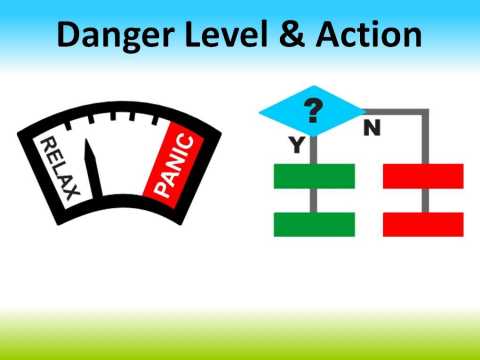 |
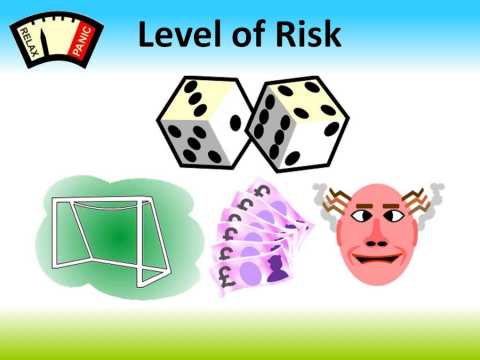 |
Just as road users benefit from categories and mental models to interpret their environment, they also rely on mental models and scenarios as shortcuts to assign a danger level, imagine possible outcomes, and decide what actions to take
This decision process will be affected by the level of risk the road user is prepared to take, which in turn is influenced by the road user's goals, motivations and state of mind |
|
There are many different and contradictory theories about risk and risk taking. But they broadly agree that road users adapt their behaviour, often subconsciously, in response to perceived risk
Couple this with the idea that the primary goal of most road users is to reach their destination as quickly and as safely as possible, then a wide, straight road which has low levels of perceived risk will tip the balance in favour of speed over safety
Our road design cannot change people's goals or motivation, but we can change perceived risk. As already mentioned, including certain visual cues can trigger particular mental models and speed control behaviours even in the absence of actual hazards and risks |
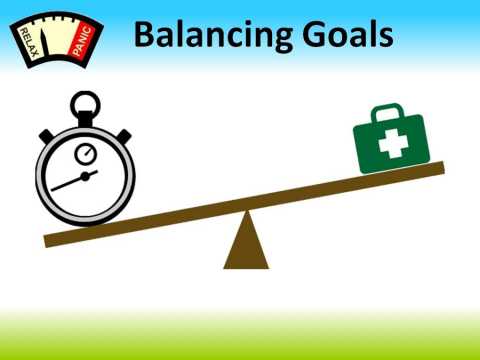 |
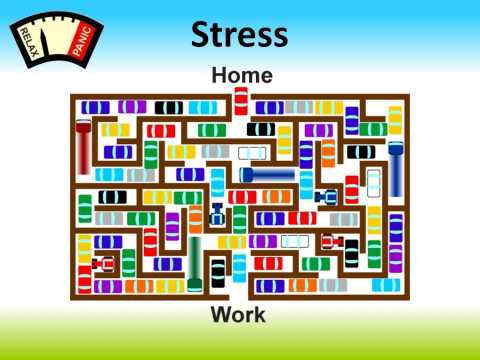 |
Stress will affect the road user's state of mind and stressed road users are more likely to make impaired decisions, such as underestimating danger levels and selecting inappropriate actions
Major causes of stress include being lost, congestion, and slow moving traffic
These all increase journey times, which goes against the road user's primary goal of reaching their destination as quickly as possible, and will lead to increasingly dangerous behaviours like speeding (which I'll cover later on), overtaking, and jumping traffic lights |
|
To prevent overtaking, it's tempting to rely on double white lines along the centre of the road
However, we must remember that road signs and markings do not in themselves provide any safety. Any actual safety benefits depend on the actions of the road user in response to the signs and markings |
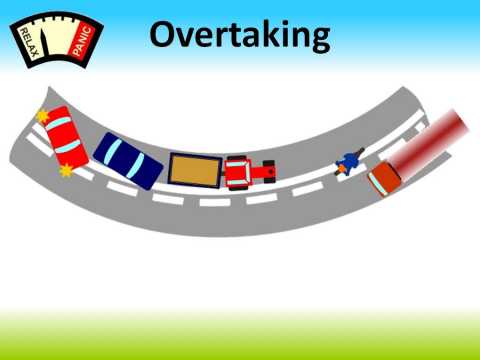 |
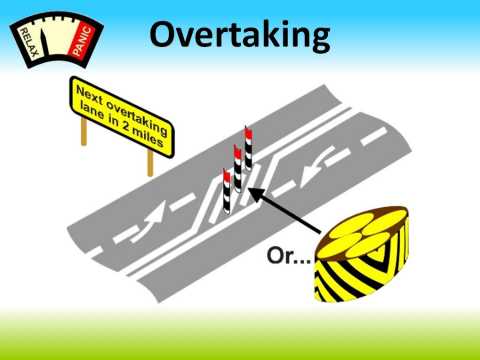 |
Therefore, instead of working against the motorist, we could work with them, for example by providing sections of road at regular intervals where overtaking is possible and safe
Maybe existing wider single carriageway trunk roads could be converted to alternating 2 + 1 lanes (two lanes in one direction, one lane in the other) as is commonplace in many countries, but usually only seen as climber lanes in the UK
Such layouts have a poor safety record, but by using modern road markings, collapsible marker posts, or even water filled barriers or crash cushions, we can recreate this type of road more safely
An added bonus is that the three narrower lanes will encourage slower overall travel speeds than two wider lanes |
|
The phasing and timing of traffic lights also affect whether road users engage in risky behaviour
If the amber phase is too short this increases the risk of rear impact collisions, while if too long the risk of side impacts on the crossing is greater
If the green phase is too short, the red phase is too long, or if there are long queues, then motorists are more likely to jump red traffic lights
The worst offenders are usually commuters and locals who get to know the phasing of each set of traffic lights and adjust their mental models accordingly |
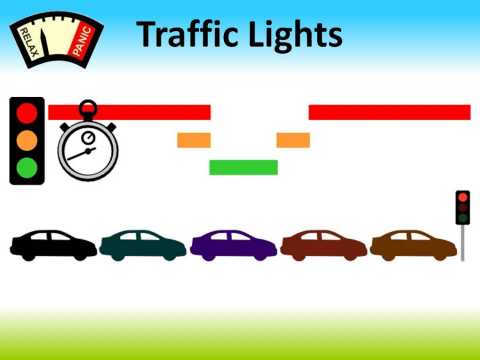 |
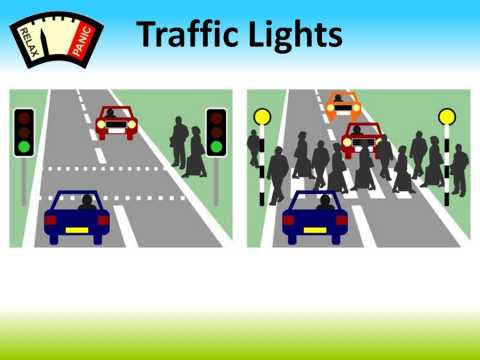 |
Traffic light controlled pedestrian crossings can encourage motorists to speed up in order to 'catch' a green light, particularly if they see waiting pedestrians
Therefore zebra crossings can be more suitable in residential areas because there is no green light, and also this type of crossing gives priority to pedestrians
However, zebra crossings are less suited where there are large, prolonged flows of pedestrians, for example town centre high streets. In this situation, near constant flows of pedestrians can mean traffic goes nowhere, prompting impatient drivers to cross the zebra crossing dangerously |
|
Pedestrians and cyclists can also engage in risky behaviour. For example, most pedestrians and cyclists prefer to take the shortest and most direct route, part of what's called 'energy-economy principles', as it requires less effort or energy expenditure
This explains why many pedestrians and cyclists prefer to cross a road, even if more dangerous, than divert their journey over a footbridge, or via a subway or controlled crossing
The more complicated we make the crossing, the more likely pedestrians and cyclists are to ignore or mis-use it. Complications include guard-railing, indirect routes, staggered crossings, multiple phase crossings, and long wait times
Guard-railing has the added problem of potentially trapping errant pedestrians in the carriageway, and cyclists can feel hemmed in by the railings when traffic passes too close
So we need to design simple and direct pedestrian crossings to encourage safety and compliance |
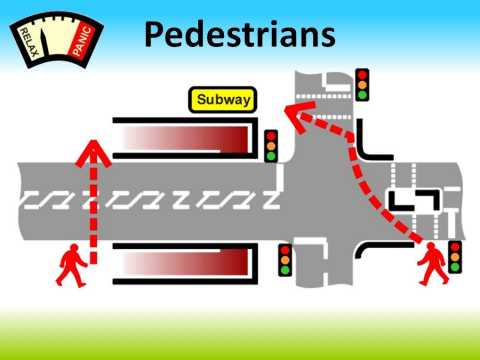 |
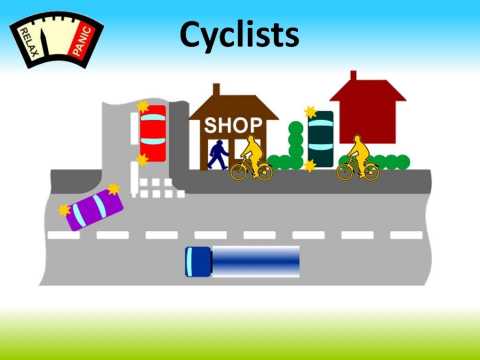 |
I've already mentioned how road users rely on mental models to assign a danger level, imagine possible outcomes, and decide what actions to take
Unfortunately these mental models can be incorrect across wide sections of society, and self-reinforced by people watching those around them engaging in incorrect behaviours. As it's almost impossible to change these mental models, our road design needs to accommodate their errors instead
Such an example of incorrect assumptions is the belief among cyclists that it's safer to ride on pavements than on the road
This is often incorrect because pedestrians and motorists don't expect and therefore don't look out for cyclists on pavements. Motorists pulling out of side roads or out of their driveways, and pedestrians stepping out of doorways directly onto pavements, can all pose hazards to pavement cyclists (and vice versa)
So we can increase driveway visibility splays, create wider pavements so cyclists have more space to swerve around hazards, or provide more cycle paths and cycle lanes to entice cyclists off the pavement |
Stopping and starting at traffic lights can use up a lot of energy for cyclists, which explains why many of them are prepared to jump red traffic lights, despite the increased danger to themselves and to other road users like pedestrians still crossing at the traffic lights
These cyclists will often have distorted judgement of the risks and misplaced expectations of how other road users will behave - for example cyclists expect other road users to stop or get out of their way. This is part of a phenomenon called 'self-serving interpretations' where people forget mistakes and near-misses and instead focus on and recall successes
Our road design cannot force cyclists to adopt safer behaviour, but it can be adapted to take their behaviour into account. For example in an urban area with high cycle usage and a comprehensive cycle route network, we could consider adapting traffic light phasing to provide green waves for cyclists, using dedicated cycle-only traffic signals, instead of focusing on green waves for motorised vehicles as is typically the case at present
|
Another example of mistaken mental models is motorists who park their vehicles half-on/half-off pavements because they fear passing vehicles may clip their door mirrors if parked fully on the road. They also feel safer getting into and out of their vehicle when parked on the pavement
However, depending on the road width and remaining free space, parking your vehicle partly on the pavement can actually increase the risk of damage to your door mirror and side panels, because it encourages vehicles to squeeze past through the wider remaining space, often without success
Parking on pavements can also damage the pavement surface and force pedestrians to walk in the carriageway. Pedestrians on the opposite side of the road can feel unsafe as well when vehicles on their side move towards the kerb to avoid oncoming traffic in the middle of the road
The wider remaining space can also encourage faster travel speeds
So to reduce the amount of pavement parking we could consider increasing formal parking provision, or placing bollards along the kerb line. Double yellow lines are often not a deterrent, and on occasion can even encourage pavement parking |
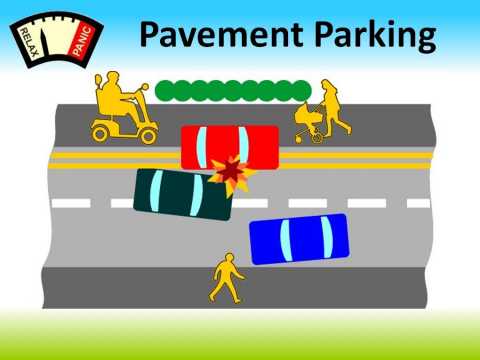 |
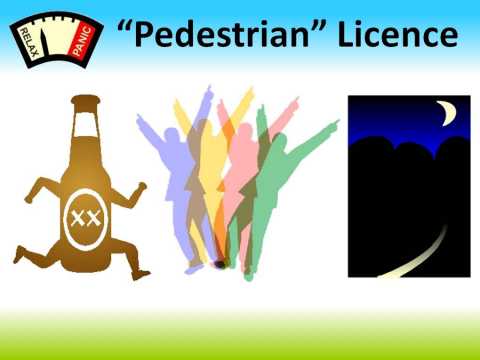 |
A third common incorrect mental model relates to drivers assuming that pedestrians are fit and able, unless obviously to the contrary
It's reasonable to assume that drivers, and to a lesser degree cyclists, are sober and unaffected by drugs, while driving
But the same cannot be said of pedestrians as there's no such thing as a 'pedestrian licence' and pedestrians are permitted to walk on most public highways while drunk or under the influence of drugs - both illegal and legal. Also, pedestrians have no obligation to make themselves visible and it's commonplace to see people dressed all in black walking along unlit or poorly lit roads at night
Therefore our road design needs to take into account this imbalance of expectations versus reality, by providing not just the minimum requirements but thinking further about pedestrians' needs and abilities |
A further example of a mismatch between expectations and reality is the expected versus actual behaviour of children on our roads
Motorists often assume that children will behave like typical pedestrians. However, young children can muddle up or skip some of the mental process, and they also have worse impulse control
For example a child eager to cross a road may fail to look for vehicles before crossing, or mistakenly look for vehicles after having crossed. Even if a child does look out for vehicles they may not always correctly perceive the risks - for example they may still think a car poses a risk even after it has passed them by, or they will think a clear road is safe without appreciating that a vehicle could appear from around a bend or over the brow of a hill
There is much debate about how a road design can protect children more effectively - on the one hand using guard-railing and controlled crossings to segregate children from motorists, or on the other hand creating 10 MPH home zones or 20 MPH shared streets and putting more responsibility on the motorist. The reality is that each system has its advantages and disadvantages and will be more appropriate in some locations, but not in others
|
The final step is to implement the action. Mistakes at this stage are related to road user ability
As already mentioned, road designs tend to assume a standard level of road user ability
However, these levels change as we get older, and with an increasing number of elderly drivers predicted, we must consider their needs more in the future and adapt our road designs appropriately |
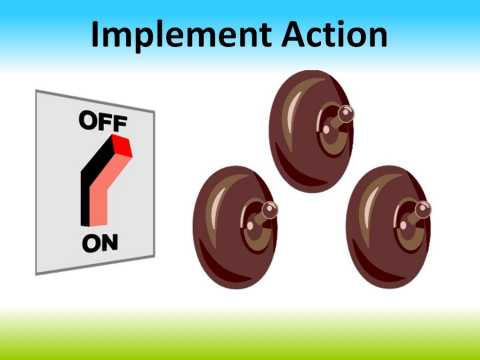 |
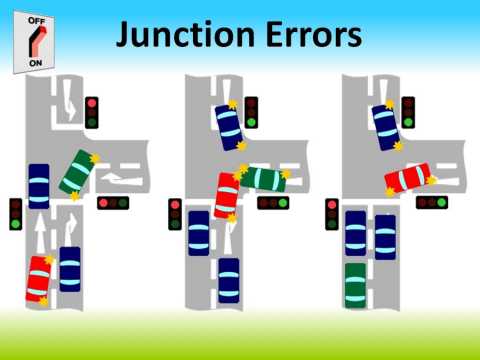 |
Even though older drivers have more experience and better developed mental models, they are still more likely to misinterpret road signs and traffic lights
Here we have an unusual, but not atypical, junction where an exit from a dual carriageway joins two-way traffic on a bend, and three examples of incorrect driver behaviour
Firstly, older drivers are more likely than average drivers to be in the wrong lane at junctions and trying to get into the correct lane can cause conflict and increased crash risk
Secondly, they're more likely to jump red traffic lights unintentionally
And thirdly, they're more likely to go the wrong way on one-way streets or carriageways - particularly slip-roads to dual carriageways |
|
To resolve these issues we need to make our road designs more forgiving, so that lost or confused drivers can return to their desired route. We also need to consider more seriously how to react to one-way mistakes
Replacing traffic light junctions with roundabouts enables motorists to perform U-turns more safely and return to their original route. An added idea is to include U-turn destinations on more road signs, for example when approaching a roundabout
Anxiety, and its associated poor driving behaviour, can increase significantly if a lost motorist never sees their destination on any road signs - just such a situation if they are driving away from their destination. So including information on road signs about where a road comes from could reduce anxiety levels, even if to the average road user it seems unnecessary
'Wrong Way - Go Back' road signs are commonplace in many countries, such as the USA. Maybe these signs should be placed on the backs of existing road signs in the UK - for example on exit slip roads from dual carriageways and motorways |
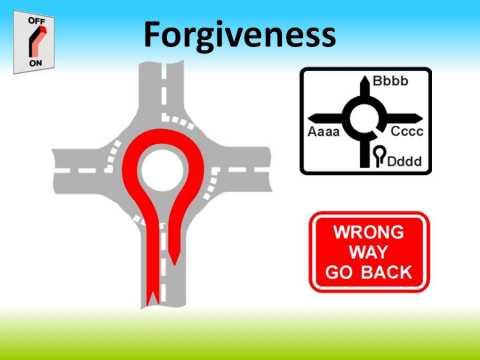 |
Because older drivers travel more slowly it takes them longer to complete a manoeuvre, for example travelling through traffic lights or turning across traffic at non-signalled junctions. This exposes them to conflict with other vehicles for longer time periods. Therefore the phasing of traffic lights should be changed to accommodate this where possible, or maybe non-signalled junctions should be replaced with either traffic lights or mini-roundabouts to remove turning conflicts
The physical layout at junctions will also need further consideration because many elderly drivers will have limited neck and shoulder movement, so they will be less able to look over their shoulder - for example when on slip roads joining motorways and dual carriageways. Maybe approach angles for slip roads should be increased?
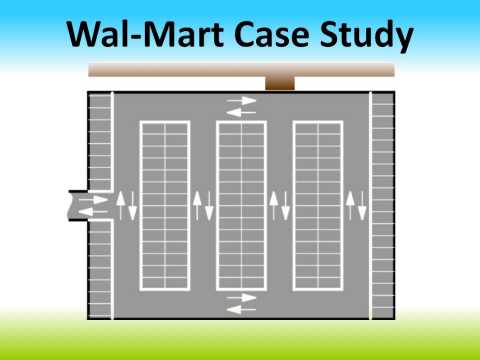 |
I end this section with a look at a case study of a Wal-Mart car park in Mississippi. As I wasn't able to determine which of the 66 Wal-Marts in Mississippi the study referred to, I've created a simple car park layout for this presentation, and applied the findings to this layout |
|
Researchers monitored the behaviour of traffic in a car park to see if any patterns could be identified
In uncongested conditions, for example early morning, they noticed two different behaviour groups:
The first group parked along the row opposite the store entrance, the second group would take the first space available, usually between the car park entrance and the store entrance
The first group, when interviewed, cited security as a major factor - being able to see the store entrance from their car, and walk in a straight line to the entrance were important for them. This group were mostly women
The second group, mostly men, cited time as their principal motivation - they didn't want to waste time finding a space, and would often underestimate how long it took to walk from their car to the store entrance |
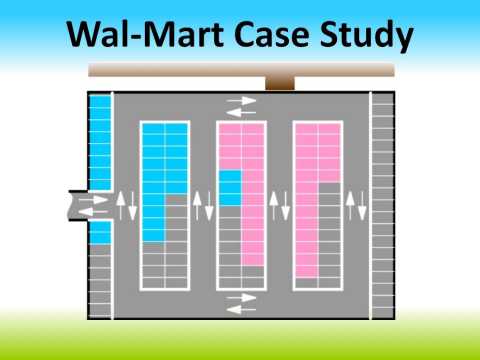 |
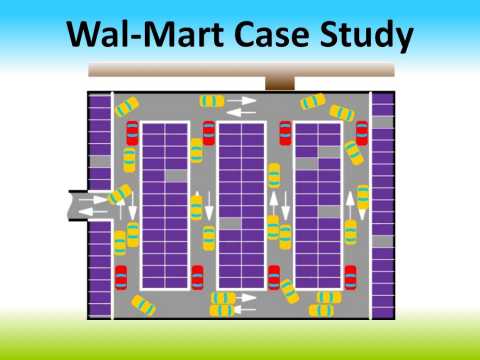 |
During congested conditions, for example weekends, the researchers noted two distinct car-parking-space search strategies - this time not linked to gender, and people would switch back and forth:
The first strategy they named 'active' - here motorists drive around the car park looking for spaces. If they cannot find a space and then see a shopper pushing a full trolley they follow the shopper to their car, wait for the shopper to load up and leave, and then take that space
The second strategy they named 'passive' - here a motorist waits at the end of a row for any shopper to return to their car in that row, load up and leave. Then our motorist takes that space
The researchers noted that most people adopted the active strategy, even though getting a space was statistically more successful using the passive strategy
When interviewed, people said they behaved as they did based on expectations and previous experience |
|
Using this information, I've adapted my simple car park layout to make it more effective and safer |
 |
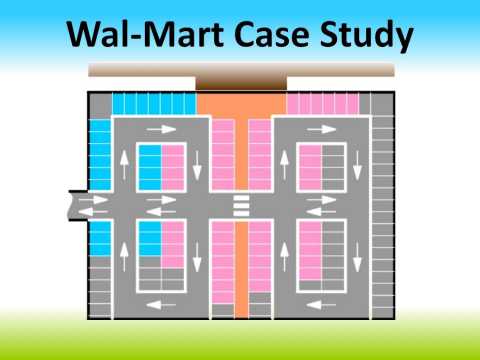 |
The main changes are that:
(i) I doubled the size of the store entrance so that it now looks on to two rows - thus doubling the available space for the safety-conscious group
(ii) I increased the number of spaces around the edge of the car park between the car park entrance and store entrance - thus improving accessibility for the time-strapped group |
|
(iii) I replaced the two-way traffic with a one-way system so that active seekers don't need to double back on themselves, and
(iv) I split the rows in two, with a central two-way access road, thus doubling the number of rows available for passive seekers, assuming a maximum of one passive seeker per row
The previous two-way traffic system could lead to conflicts with two seekers approaching the same parking space but from opposite directions. Switching to a one-way system helps reduce such conflicts, and narrower lanes also mean there's now space available for a pedestrian path (and zebra crossing) through the middle of the car park
The total number of parking spaces was reduced slightly due to the reorganisation, but safety has been improved |
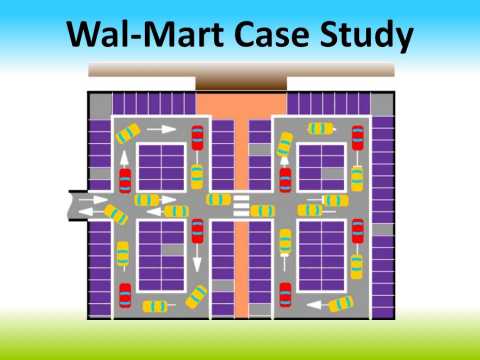 |
The next section focuses on why motorists don't obey the rules, and the part road design plays in this - in particular why motorists speed































































